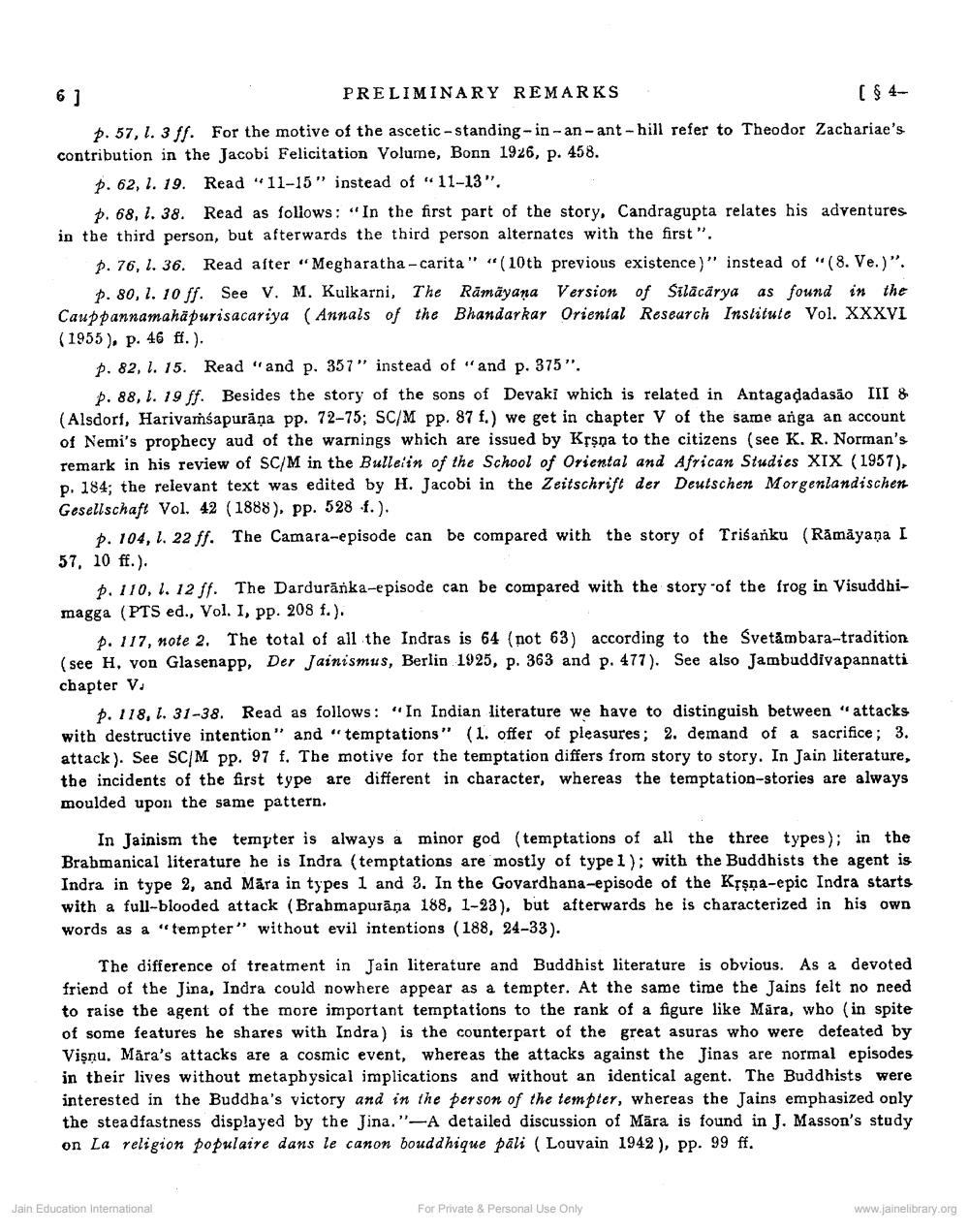________________
6 ]
PRELIMINARY REMARKS p. 57, 1. 3.fl. For the motive of the ascetic-standing-in-an-ant-hill refer to Theodor Zachariae's contribution in the Jacobi Felicitation Volume, Bonn 1926, p. 458.
p. 62, 1. 19. Read "11-15" instead of " 11-13".
p. 68, 1. 38. Read as follows: "In the first part of the story, Candragupta relates his adventures in the third person, but afterwards the third person alternates with the first".
P. 76, 1. 36. Read after "Megharatha - carita" "(10th previous existence)" instead of "( 8. Ve.)".
P. 80, 1. 10 ff. See V. M. Kulkarni, The Rāmāyana Version of Silācārya as found in the Cauppannamahäpurisacariya (Annals of the Bhandarkar Oriental Research Institute Vol. XXXVI (1955), p. 46 ff.).
p. 82, 1. 15. Read "and p. 357" instead of "and p. 375".
p. 88, 1. 19 ff. Besides the story of the sons of Devaki which is related in Antagadadasão III 8 (Alsdorf, Harivamśapurāņa pp. 72-75; SC/M pp. 87 f.) we get in chapter V of the same anga an account of Nemi's prophecy aud of the warnings which are issued by Krsna to the citizens (see K. R. Norman's remark in his review of SC/M in the Bulletin of the School of Oriental and African Studies XIX (1957), p. 184; the relevant text was edited by H. Jacobi in the Zeitschrift der Deutschen Morgenlandischen Gesellschaft Vol. 42 (1888), pp. 528 f.).
p. 104, 1. 22 ff. The Camara-episode can be compared with the story of Trišanku (Rāmāyaṇa I 57, 10 ff.).
p. 110, 1. 12 ff. The Dardurānka-episode can be compared with the story of the frog in Visuddhimagga (PTS ed., Vol. I, pp. 208 f.).
p. 117, note 2. The total of all the Indras is 64 (not 63) according to the Svetambara-tradition (see H, von Glasenapp, Der Jainismus, Berlin 1925, p. 363 and p. 477). See also Jambuddivapannatti chapter V.
p. 118, 1. 31-38. Read as follows: "In Indian literature we have to distinguish between "attacks with destructive intention" and "temptations" (1. offer of pleasures; 2. demand of a sacrifice; 3. attack). See SCIM pp. 97 f. The motive for the temptation differs from story to story. In Jain literature, the incidents of the first type are different in character, whereas the temptation-stories are always moulded upon the same pattern.
In Jainism the tempter is always a minor god (temptations of all the three types); in the Brabmanical literature he is Indra (temptations are mostly of type 1); with the Buddhists the agent is Indra in type 2, and Māra in types 1 and 3. In the Govardhana-episode of the KȚşna-epic Indra starts with a full-blooded attack (Brahmapurāna 188, 1-23), but afterwards he is characterized in his own words as a "tempter" without evil intentions (188, 24-33).
The difference of treatment in Jain literature and Buddhist literature is obvious. As a devoted friend of the Jina, Indra could nowhere appear as a tempter. At the same time the Jains felt no need to raise the agent of the more important temptations to the rank of a figure like Māra, who (in spite of some features he shares with Indra) is the counterpart of the great asuras who were defeated by Vişnu. Māra's attacks are a cosmic event, whereas the attacks against the Jinas are normal episodes in their lives without metaphysical implications and without an identical agent. The Buddhists were interested in the Buddha's victory and in the person of the tempter, whereas the Jains emphasized only the steadfastness displayed by the Jina."-A detailed discussion of Māra is found in J. Masson's study on La religion populaire dans le canon bouddhique pali (Louvain 1942), pp. 99 ff.
Jain Education International
For Private & Personal Use Only
www.jainelibrary.org




